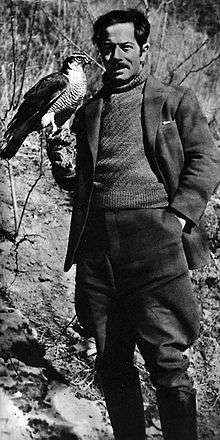Sten Bergman

Sten Bergman (20 October 1895 – 19 February 1975) was a Swedish zoologist, who visited Korea, Kamchatka, Papua New Guinea, and many other places.
Career
Bergman was born in Ransäter, Sweden and was the son of professor Johan Bergman and Kerstin Henriksson. He passed his studentexamen in 1914 and obtained a Bachelor of Arts degree in 1917, Licentiate of Philosophy degree in 1925 and became an honorary doctor in Stockholm in 1952.[1]
He was acting assistance and acting director of the Swedish Museum of Natural History during different periods from 1923. Bergman was a popular science lecturer from 1923 and conducted tours in Central Europe in 1926, 1933 and 1955, in Italy in 1955 as well as in Japan in 1960 and 1962. He was explorer in the Kamchatka Peninsula from 1920 to 1923, in the Kuril Islands from 1929 to 1930, in Korea from 1935 to 1936 and in New Guinea from 1948 to 1949, 1952 to 1953 and from 1956 to 1959.[1]
Bergman was an honorary member of the Royal Danish Geographical Society and corresponding member of the Geographische Gesellschaft i Vienna.[1]
Bergman's bear
In 1920 Bergman observed the skin of a black Kamchatkan bear, and noted it was much larger than bears commonly found in the area, with shorter hair.[2] He also described several large tracks that had been found and termed the bear Ursus arctos piscator, although it is usually known as Bergman's Bear. No sightings of the species have been reported since Bergman's description in 1936.
Expedition to Korea
Bergman's 1938 book In Korean Wilds And Villages recounts an expedition to study the birds found in the North of Korea.[3] Traveling with a taxidermist, Bergman also collected specimens for the Swedish Natural History and Ethnographical museums. The book also provides commentaries on various aspects of Korean culture and wildlife.
Cannibalism In New Guinea
In his 1962 book My father is a cannibal, Bergman relates the experiences of two years spent with his wife in New Guinea from 1956 to 1958.[4] He describes his adoption by the Papuan Chief Pinim, and his wife, Akintjes, and the festivals, ceremonies and cannibalistic practises of the native Papuans. The book also includes his observations of interesting plants and animals, including the tree kangaroos, forest turkeys, flame-coloured lianas, Bauhinia and flying beetles.
Personal life
In 1920, Bergman married Dagny Lindhé (born 1890), the daughter of major Nils Lindhé and Ida Arnell.[1] He was the father of the nature photographer and writer Astrid Bergman (1927–2015).[5] Bergman died in 1975 and was buried at Salem cemetery in Salem Municipality on the cape closest to Bornsjön.[6]
Awards and decorations
Bergman's awards:[1]
- Commander of the Order of the Polar Star
- Knight of the Order of Vasa
- Officer of the Order of Orange-Nassau
- Anders Retzius medal in silver
- Royal Swedish Academy of Sciences' Linné Medal in gold
- Travellers Club's medal in silver
- Johan August Wahlberg's medal in silver
Bibliography
- Through Kamchatka by Dog-Sled and Skis by Sten Bergman (Seeley, Service & Co., Ltd., 1927), ISBN 978-1-135-48149-0.[7]
- Sport and exploration in the far east by Sten Bergman (Methuen & Co. 1933)[8]
- In Korean Wilds And Villages by Sten Bergman (1938), Translated by Frederic Whyte.[3]
- My Father Is A Cannibal by Sten Bergman (Robert Hale, 1961)[4]
- Blåhake, Tiger, Pungbjörn Och Andra Djur by Sten Bergman, Albert Bonniers Förlag 1947"/>
References
- 1 2 3 4 5 Harnesk, Paul, ed. (1962). Vem är vem? 1, Stor-Stockholm [Who is who? 1, Greater Stockholm] (in Swedish) (2nd ed.). Stockholm: Vem är vem. p. 123.
- ↑ Cryptozoology.com
- 1 2 www.RareOrientalBooks.com Author: BERGMAN, Sten
- 1 2 My Father Is A Cannibal - By Sten Bergman - OZtion Auction Item 1682785
- ↑ Uddling, Hans; Paabo, Katrin, eds. (1992). Vem är det: svensk biografisk handbok. 1993 [Who is it: Swedish biographical handbook. 1993] (in Swedish). Stockholm: Norstedt. p. 111. ISBN 91-1-914072-X.
- ↑ Åstrand, Göran; Aunver, Kristjan (1999). Här vilar berömda svenskar: uppslagsbok och guide (in Swedish). Bromma: Ordalaget. p. 23. ISBN 91-89086-02-3.
- ↑ Powell's Books - Through Kamchatka by Dog-Sled and Skis by Sten Bergman
- ↑ Bergman, Sten; Sport And Exploration In The Far East